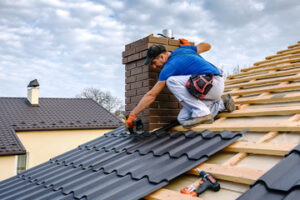A roof is a complex structure that protects against rain, snow, sunlight, and extremes of temperature. It can also add a distinctive architectural style to a home.
Roofing is a challenging, exciting form of building construction. There are 64 practical types of roofs. The most common are shingle roofs. Contact Canton Roofer now!

There are a wide variety of materials available for your roof. You’ll want to choose a material that suits your home, budget and climate. The type of roofing you choose will affect the value of your home as well.
One of the most common roofing materials is asphalt shingles. This type of roofing is inexpensive and easy to install. However, it may not last as long as other types of roofing. In addition, it may be susceptible to moss and mildew. Other types of roofing include tile, metal and rolled roofing.
Tile roofs can add a great deal of charm to your home and are extremely durable. They are also resistant to fire and can withstand high winds, extreme temperatures and hail. The downside is that they can be expensive, especially if you use clay tiles.
Fibre cement sheets are another option that will last a very long time. They are available in a variety of colours to match your building style and are sustainable.
Rolled roofing is a cost-effective material that is suitable for low-slope roofs. It consists of large rolls of a watertight material topped with mineral granules. This material is durable and can withstand the elements but is not as attractive as other roofing materials.
Slate roofs are another highly aesthetically pleasing option, but they’re also expensive. They are fireproof and can withstand high winds, extreme temperature fluctuations, and hail. You can choose from natural slate or synthetic alternatives like fiber cement slate or bituminous styles.
Rubber is a more affordable option that can be made to look like other roofing materials. It is lightweight, puncture-resistant, and has good heat-reflecting properties. It does not last as long as other roofing materials, though, and may have a distinctive odor.
There are many other types of roofing materials that you can choose from, including corrugated iron, galvanised steel, and polycarbonate. The latter is a relatively new type of roofing that has become very popular for its durability, low maintenance requirements, and energy efficiency. It is also resistant to chemicals and bacterial growth, making it ideal for residential use.
A roof is designed to protect the interior of a building from rain, snow, extreme heat and cold, sunlight, and other weather insults. It is constructed in a wide variety of forms, including flat, pitched, vaulted, or domed and in combinations as dictated by technical, economic, or aesthetic considerations.
Before beginning a roofing project, the contractor should make sure that all required permits have been obtained. The contractor must also prepare the job site by removing all vehicles from the area, covering any exposed items, and moving any furniture or other valuables to prevent them from being damaged during the roofing process.
The underlayment is then laid over the prepared surface and nailed down. The nails may be close together along the edges and spread out more toward the middle, or they may be nailed every six inches (150 to 250 centimeters). When the first row is complete, the contractor will overlap it with the next one by at least six inches, and fasten them in the same pattern.
Some manufacturers provide credentialed contractors to install their products, and homeowners insurance companies may have networks as well. If you are installing a new roof on your own, ask the manufacturer for a list of recommended contractors.
The roof of any building is assaulted by wind, rain, hail, ice, intense sunlight and a host of other weather elements. As such, a roof must be constantly reinforced or repaired to keep it from falling apart. Roofing contractors have one of the more vibrant industries in the construction business, as homeowners consistently need to re-roof their homes or repair leaks from previous damage.
The flashing around chimneys and vent pipes should be regularly inspected for signs of cracking or rust. This can lead to water leaks, and these should be promptly repaired by a roofer. A professional can also replace a damaged section of roof membrane to prevent water leaks, as well as repair the damage to the decking and insulation underneath.
In addition to regular maintenance, a procedure for inspecting and documenting the condition of a roof should be established. This inspection should be done on a biannual basis or more often in geographic locations that experience extreme weather conditions, to allow for early problem detection and repair. This inspection should include a check of the following items:
When it comes to repairs, roofers can correct materials like shingles and tar paper as well as leaky flashing. Flashing is typically metal that’s hand-bent and fixed to the roof with a combination of nails and sealant. It can wear out over time or become damaged by extreme weather. If the problem is spotted early on through regular roof inspections, it’s easy to repair with roofing cement and tar.
Unlike a fresh coat of paint or cabinets, repairing or replacing the roof is an investment in your home’s structural integrity. Choosing the right solution can save you both time and money in the long run.
Aside from repairing leaking areas, roofers can also inspect the structure and replace or re-roof the entire roof if necessary. A roof replacement is a more extensive project that involves taking off the existing shingles and installing new ones. However, it can be a more cost-effective option in the long run if your roof has extensive damage. Re-roofing is a less expensive alternative that adds a second layer of shingles on top of the old ones. However, it can’t hide any existing damages and can void or shorten the warranty on the new shingles.
The GC will be your point of contact during the entire construction process, providing you with the latest updates, status reports, and timelines for completion of each phase of the project. They will also ensure that all contractors follow safety standards and procedures during the construction of your roof. The GC will be familiar with the various roofing materials and the proper techniques for installing them, so you can rest assured that your roof is in good hands.
In addition to having extensive experience with roofing, a GC should have excellent communication skills and be able to keep track of multiple tasks at once. They should also be able to work well under pressure and manage time constraints effectively.
A GC should be able to assess the needs of each client and provide them with estimates that accurately reflect the amount of labor and materials required for the job. They should also be able to identify problems with the roof and suggest solutions that will improve its function and durability. In addition, they should be able to create and maintain positive working relationships with clients.
When hiring a GC, be sure to ask about their background and past experiences. They should be able to provide references and proof of insurance coverage. They should also be licensed by your state or province to operate as a GC.
You should also consider a GC’s level of experience in your particular industry. For example, if you’re planning to build a high-end custom home, you will want a GC that has experience with these types of builds. This will help ensure that they have the knowledge and resources necessary to address any unforeseen issues that may arise during construction.






